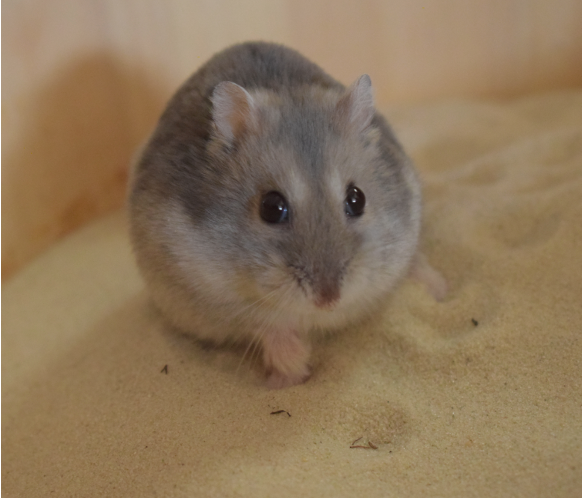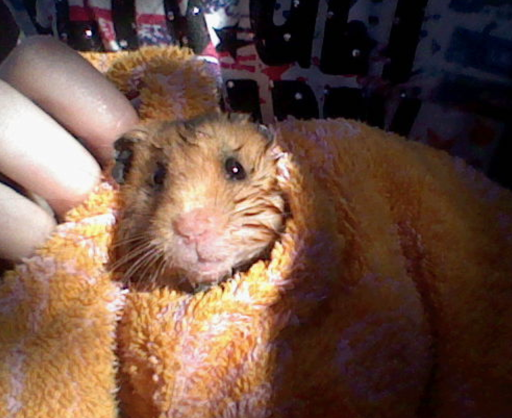The Importance of a Sand Bath
- Em

- May 10, 2020
- 4 min read
Hamsters, unless medically necessary, should never be bathed in water. It is harmful to their coats, and is overall an incredibly stressful experience for them. Instead, hamsters have a natural instinct to roll in sand to keep their coats clean & healthy. While only one species of our domesticated hamster, being the Roborovski hamster, is a true, exclusive desert dweller, the other species of hamsters we keep as pets will still encounter sand in their natural habitat range & possess the natural instinct to roll in sand to bathe.
However, not all bathing sands are created equal, with some having artificially added dyes (that can stain your pets coat!) or having high dust content that may be irritable to your pets respiratory system. Many chinchilla bathing sands in particular - even if labelled as sand and not dust - can be incredibly dusty, be sure to read the reviews of the product and consult with other hamster owners if you’re unsure of a brands quality. If you have trouble finding a quality chinchilla bathing sand where you’re from, don’t fret: 100% natural reptile sand (with no artificial dyes/added calcium) is also safe for hamster sand baths, as is children play sand - though it it recommended that you sieve play sand to remove stones/larger debris that may hurt your hamster when bathing. Play sand also has a high moisture content at first, so should be dried out before giving to your hamster (otherwise it defeats the whole purpose of giving them a sand bath to begin with!). Some also insist you bake it prior to offering to sanitise: there are varying opinions on whether this step is necessary, but there’s no harm doing so if it gives you peace of mind – it will also dry out the sand far quicker than the leaving it out in the sun, so there’s that benefit too.

Quality Sand is not the only factor you need to consider, you must also take into consideration the species of hamster you are providing the sand bath too. All hamsters need a sand bath, but what minimum size your sand bath needs to be varies amongst each species.
Roborovski hamsters (Phodopus roborovskii) are exclusive desert dwellers, so need larger sand areas: it is recommended that at least 1/3 of their enclosure be sand. If we take into consideration bare minimum enclosure size being 4,000cm^2, minimum sized sand area for a robo must be around 45cm x 30cm (or equal footprint).
The Russian Campbell (Phodopus campbelli) also has preference for more arid habitats and their habitat range shows considerable overlap with the Roborovski. While they are not exclusive desert dwellers like robos, a large sand area is of high importance and I would personally recommend 1/4 of their enclosure be sand, or at the very least sand area of 30cm x 35cm (or equal footprint) .
The Syrian Hamster (Mesocricetus auratus) has a preference for more agricultural habitat, but nonetheless they are from hot climates where the surface of their habitat would be dry dirt - dry dirt can be very dusty, and Syrians possess the natural instinct to roll around in it to clean their coats. A sand bath should be considered beneficial to provide a Syrian and be at least a minimum of 30cm x 20cm (or equal footprint).
The Winter White (Phodopus sungorus) hamster has a very diverse habitat range, which includes barren steppe regions. While they do not show such an intense preference for arid habitat like the Russian Campbell, a sand area is still important – they just do not require as large of an area. My personal recommendation as a minimum for a sand area for this species is 30cm x 20cm (or equal footprint).
The Chinese Dwarf (Cricetulus barabensis griseus) hamster also has a very diverse habitat range and has been described a ‘habitat generalist’ – they are found in a variety of habitats, including arid, and so access to a sand bath should be considered important. Likewise with the Winter White, my personal recommendation as a minimum for a sand area for the Chinese dwarf is 30cm x 20cm (or equal
Quality bathing sand is not all, nor is simply just providing a sand bath – it must also be an appropriate size for the species.

For species like the Winter White, Chinese, and Syrian hamsters circular sand baths are fine & are available in suitable sizes. I recommend a minimum of 27cm (11”) diameter.

Roborovski hamsters require larger sand areas, which may also be of a
benefit to the Campbell dwarf hamster. Additionally, providing hides
In the sand area is also beneficial and provides your pet with more sense
of security.

Please also be cautious of the depth of sand you are providing. Deep sand may encourage your hamster to burrow in it, and very deep sand poses a crushing risk – even robos who burrow in sand in the wild should not be given deep loose sand in captivity. Sand in nature increases in moisture as you dig down, which gives their wild burrows stability – this is not the case for loose sand in captivity. Sand areas should be a maximum of 4-5”/10-12cm deep.
Related Posts:











Comments